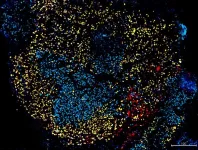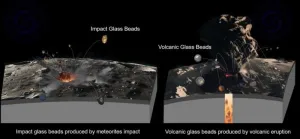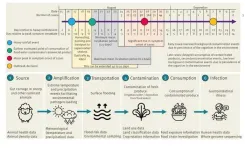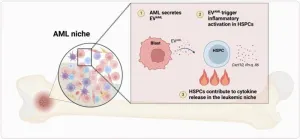(Press-News.org) There were volcanic eruptions on the Moon as recently as 120 million years ago, according to a new analysis of a lunar sample collected by the Chang’e‑5 mission. Samples collected by the Apollo, Luna and Chang’e‑5 missions have previously shown there was widespread basaltic volcanism on the Moon extending from about 4.4 to 2.0 billion years ago. The new findings demonstrate that volcanism persisted much longer than was previously suspected, at least on smaller, more localized scale. Bi-Wen Wang, Qian W.L. Zhang and colleagues sorted through more than 3000 tiny glass beads they recovered from a lunar sample collected by Chang’e‑5, examining the bead’s chemical compositions, physical textures and sulfur isotopes to distinguish potential volcanic glasses from glasses produced by meteorite impacts. They identify three beads as being of volcanic origin, then used radiometric dating to determine the volcanic beads formed 123 ± 15 million years ago. The volcanic beads contain high abundances of potassium, phosphorus and rare-earth elements, known as KREEP elements, which can produce radioactive heating. Localized heating due to KREEP elements might melt rocks in the Moon’s mantle, leading to small amounts of magma erupting to the surface, the researchers suggest. In a related Perspective, Yuri Amelin and Qing-zhu Yin discuss the difficulties in distinguishing volcanic glasses from impact glasses.
END
Tiny glass beads indicate volcanism on the Moon 120 million years ago
Summary author: Becky Ham
2024-09-05
ELSE PRESS RELEASES FROM THIS DATE:
Injected fibroblasts transform to give thin skin a tough new identity
2024-09-05
The thick and tough skin on our palms and soles, called volar skin, stands up well under high-pressure conditions. This type of skin would be welcome on the limb stumps of amputees, since these points of contact with prostheses are covered in thin, non-volar skin that can be damaged over time. Now, Sam Lee and colleagues demonstrate that an injection of volar fibroblasts into non-volar skin in a group of human volunteers can promote volar features in the thin skin that last up to five months. Based on their analysis, Lee et al. are now enrolling amputees in a phase 2 clinical trial to further explore volar fibroblasts as a future ...
Novel study reveals how aging immune system fuels cancer growth, potentially opening new avenues for prevention
2024-09-05
New York, NY [September 5, 2024]—A novel study by researchers at the Icahn School of Medicine at Mount Sinai addresses a critical yet under-explored question in cancer research: Why is aging the biggest risk factor for cancer? The study reveals how an aging immune system spurs tumor growth, offering new insights into cancer prevention and treatment, especially for older adults.
Details on the findings were reported in the September 5 Online First Release of Science [DOI:10.1126/science.adn0327]. In preclinical models, the research team found that anakinra, a drug typically used for inflammatory conditions such as rheumatoid arthritis, can be repurposed to block harmful signals between ...
Researchers prove 120-million-year-old volcanism on moon
2024-09-05
Extensive geologic evidence of ancient volcanic activity can be found on the Moon, but how long this volcanism persisted has been unclear. However, Prof. LI Qiuli’s Lab at the Institute of Geology and Geophysics of the Chinese Academy of Sciences (IGGCAS) has recently identified three volcanic glass beads from lunar soil samples collected by the Chang’e-5 mission. Their research shows that the beads were formed 123±15 million years ago (Ma), thus representing the youngest lunar ...
State-by-state data boosts bird conservation planning
2024-09-05
ITHACA, N.Y. – New data summaries from the Cornell Lab of Ornithology’s eBird platform will help state wildlife planners assess the status of bird populations that live in or pass through their state – a crucial tool in protecting species.
A team of data scientists at eBird, the participatory science platform, has packaged summaries covering every bird species, in every state, and made them available online for free. These data summaries will help states prepare their federally required ...
Study on E. coli outbreak in the UK demonstrates increasing impact of climate change on public health and food security
2024-09-05
A study published in Eurosurveillance to investigate an outbreak of Shiga toxin-producing Escherichia coli (STEC) O157:H7 in the UK identified contaminated lettuce as the most likely source of the infection, and determined that heavy rainfall and flooding may have carried STEC from animal faeces to the lettuce crops. More heavy rainfall events are expected due to climate change in the future, leading to increased impacts on health and food security.
Ahead of Field Epidemiology Day 2024, this study demonstrates the value of field investigations in quickly responding to outbreaks, improving preparedness, and protecting public health, and possible ...
Using 3D imaging to transform plastic waste recycling
2024-09-05
In a global first, University of Waterloo researchers have used 3D imaging technology to understand the fine details of microplastics, paving the way for more effective methods of plastic waste recycling.
Micro and nanoplastics, tiny particles of plastic that come from the breakdown of larger plastic items, have become an exponentially worsening environmental crisis. Due to their difficulties in safely decomposing, plastic pollution poses significant threats to ecosystems, wildlife and human health.
Scientists have struggled to understand the exact process of ...
Case for inflammatory memory for hematopoietic stem and progenitor cells in AML niche
2024-09-05
“In this research perspective, we discuss recent work from our lab describing an active role of HSPCs in AML and the potential implications.”
BUFFALO, NY- September 5, 2024 – A new research perspective was published in Oncotarget's Volume 15 on September 4, 2024, entitled, “Trained and ready - the case for an inflammatory memory for hematopoietic stem and progenitor cells in the AML niche.”
As noted in the abstract of this paper, lifelong hematopoiesis is sustained by the crosstalk between hematopoietic stem and progenitor cells (HSPCs) and specialized bone marrow ...
For many animals sleep is a social activity, but it’s usually studied as an individual process
2024-09-05
Group sleeping can impact when animals sleep, how long they sleep for, and how deeply they sleep. For example, groups of meerkats time their sleep according to “sleep traditions”; olive baboons sleep less when their group size increases; bumblebees suppress sleep in the presence of offspring; and co-sleeping mice can experience synchronized REM sleep. To fully understand both sleep and animal social structures, we need to pay more attention to the “social side” of sleep, animal behaviorists argue in an opinion paper publishing September 5 in the Cell Press journal ...
Human brain cancers fire electrical impulses – researchers reveal unexpected hybrid cell spiking the signals
2024-09-05
Researchers at Baylor College of Medicine and the Jan and Dan Duncan Neurological Research Institute at Texas Children’s Hospital have uncovered a new cell type in the human brain.
The study published in Cancer Cell reveals that a third of the cells in glioma, a type of brain tumor, fire electrical impulses. Interestingly, the impulses, also called action potentials, originate from tumor cells that are part neuron and part glia, supporting the groundbreaking idea that neurons are not the only cells that can generate electric signals in the brain. The scientists also discovered ...
Pancreatic cancer: study finds most early staging inaccurate
2024-09-05
Staging of patients with early pancreatic cancer is inaccurate as much as 80% of the time, according to a new Cedars-Sinai Cancer study published in the peer-reviewed journal JAMA. The finding underscores the urgent need for advancements in diagnostic technology and staging, which could significantly alter early pancreatic cancer treatment and research.
In this study, investigators looked at data from more than 48,000 patients in the National Cancer Database. Based on preoperative imaging, all of the patients in the study had either stage 1 or stage 2 pancreatic cancer.
Following surgery to remove their tumors, more than 78% of stage ...
LAST 30 PRESS RELEASES:
Interaction of climate change and human activity and its impact on plant diversity in Qinghai-Tibet plateau
From addressing uncertainty to national strategy: an interpretation of Professor Lim Siong Guan’s views
Clinical trials on AI language model use in digestive healthcare
Scientists improve robotic visual–inertial trajectory localization accuracy using cross-modal interaction and selection techniques
Correlation between cancer cachexia and immune-related adverse events in HCC
Human adipose tissue: a new source for functional organoids
Metro lines double as freight highways during off-peak hours, Beijing study shows
Biomedical functions and applications of nanomaterials in tumor diagnosis and treatment: perspectives from ophthalmic oncology
3D imaging unveils how passivation improves perovskite solar cell performance
Enriching framework Al sites in 8-membered rings of Cu-SSZ-39 zeolite to enhance low-temperature ammonia selective catalytic reduction performance
AI-powered RNA drug development: a new frontier in therapeutics
Decoupling the HOR enhancement on PtRu: Dynamically matching interfacial water to reaction coordinates
Sulfur isn’t poisonous when it synergistically acts with phosphine in olefins hydroformylation
URI researchers uncover molecular mechanisms behind speciation in corals
Chitin based carbon aerogel offers a cleaner way to store thermal energy
Tracing hidden sources of nitrate pollution in rapidly changing rural urban landscapes
Viruses on plastic pollution may quietly accelerate the spread of antibiotic resistance
Three UH Rainbow Babies & Children’s faculty elected to prestigious American Pediatric Society
Tunnel resilience models unveiled to aid post-earthquake recovery
Satellite communication systems: the future of 5G/6G connectivity
Space computing power networks: a new frontier for satellite technologies
Experiments advance potential of protein that makes hydrogen sulfide as a therapeutic target for Alzheimer’s disease
Examining private equity’s role in fertility care
Current Molecular Pharmacology achieves a landmark: real-time CiteScore advances to 7.2
Skeletal muscle epigenetic clocks developed using postmortem tissue from an Asian population
Estimating unemployment rates with social media data
Climate policies can backfire by eroding “green” values, study finds
Too much screen time too soon? A*STAR study links infant screen exposure to brain changes and teen anxiety
Global psychiatry mourns Professor Dan Stein, visionary who transformed mental health science across Africa and beyond
KIST develops eco-friendly palladium recovery technology to safeguard resource security
[Press-News.org] Tiny glass beads indicate volcanism on the Moon 120 million years agoSummary author: Becky Ham




